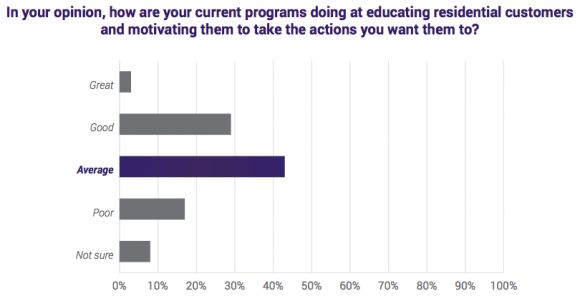Consumer demand for cleaner energy and new technologies to control energy use is transforming the electricity sector.
In this new environment, utilities see customer engagement as an integral part of their industry's future. But they're struggling to get residential consumers to understand -- and care about -- utility programs.
Many utilities acknowledge their customer education programs are ineffective and that they're unsure how to develop new ones, according to a survey of 144 power-sector executives conducted by Utility Dive for NTC Corporate, an outreach organization sponsored by utilities.
Energy efficiency and the emergence of distributed energy resources are major drivers of this shift to a more consumer-centric business model. Ninety-seven percent of utility executives said they see distributed energy changing the way they educate residential customers over the next five years.
The vast majority of respondents (76 percent) said that consumer education is a higher priority for their business today than it was a decade ago. The transition to a more consumer-oriented approach "is a major change for an industry that has long worked within the confines of the traditional cost-to-serve monopoly model," according to the report.

But while utilities are starting to shift their business focus, only 2 percent believe they're doing a great job of it.

Engaging customers has proven to be difficult. Just over 40 percent of utilities surveyed said consumer interest was the biggest challenge in spreading the word about their energy-efficiency and demand-side management programs. More than half of utilities (57 percent) said they were struggling to prove that consumer education initiatives produce a return on investment.
Still, most utilities think they're primarily responsible for residential customer education, as opposed to federal and state regulators, third-party program implementers, and technology manufacturers.
Half of utility respondents think energy efficiency is the most important area for them to focus their outreach efforts. Demand response was deemed to be the second most important area. Renewables and distributed energy ranked last on the list.
The reason for that is twofold. First, distributed energy is generally more capital-intensive than energy efficiency measures and so it requires more customer persuasion. Second, many utilities are barred from selling distributed generation to their customers, and so they may see it as competition.
"It is not yet clear how utilities are educating their customers about rival services like distributed energy -- if they are at all," according to the report.

Typically, customers only interact with the utility when the power goes out or they get a higher-than-average bill. This doesn't make for a great foundation when it comes to the utility-customer relationship. But it doesn't fully explain why utilities are having mixed success in convincing customers to care about their energy saving programs.
Many utilities think it's the customer's fault. Thirty-five percent of survey respondents believe customers are hesitant to save energy because they don't think their individual actions make a difference. Twenty-three percent think customers simply don't know enough about these programs. Twenty percent blame their own industry for not successfully communicating the benefits of their programs.
Nearly three-quarters of respondents (72 percent) think the best way to motivate customers to participate in utility programs comes down to incentives. These typically take the form of tax breaks and rebates. But in order for this approach to work, effective education must occur. Incentives aren't worth much if customers don't know about them.
A majority of utilities (68 percent) say they don't know how to measure return on investment from their customer education programs. The inability to prove ROI, they say, is the biggest challenge in getting public utility commissions to approve cost recovery for outreach efforts. Nonetheless, 71 percent of utility executives expect funding for residential customer education programs to increase over the next five years.
Customer education programs are critical to the future of the electricity sector, and electric utilities know that. Failing to take action just isn't an option.
"The utilities that succeed in educating their residential customers may be [the best positioned not only] to survive, but [also to] thrive in the new customer-centric electricity landscape that is now taking shape," according to the report.



